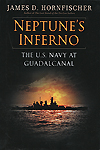 Neptune’s Inferno: The U.S. Navy at Guadalcanal, by James D. Hornfischer, Bantam, New York, 2011, $30
Neptune’s Inferno: The U.S. Navy at Guadalcanal, by James D. Hornfischer, Bantam, New York, 2011, $30
The U.S. Marine landings on Guadalcanal on Aug. 7, 1942, marked the United States’ first land-based offensive against Japan—or any Axis power, for that matter. It was also the largest, most complex combined military operation the United States had attempted to that time. In contrast to the Operation Torch landings in North Africa that November, Guadalcanal was launched on very short notice and used only the modest forces available in the region. In his new book, James D. Hornfischer describes the Guadalcanal campaign as “the most critical major military operation America would ever run on such a threadbare shoestring.”
The Guadalcanal invasion touched off a fight to the finish between two of the world’s greatest military machines over one of the most remote expanses of real estate on the planet. While the clashes at sea cost the combatants comparable numbers of warships, aircraft and men, the land battles cost Japanese ground forces many times the losses suffered by the U.S. Marines and Army.
The struggle for Guadalcanal imposed a difficult and costly learning curve upon American forces. The Battle of Savo Island, fought on the night of Aug. 8–9, 1942, remains the worst combat defeat ever suffered by the Navy. Still, it was able to hang on, adopt new methods of warfare and eventually best the enemy on his own terms.
Neptune’s Inferno may prove controversial among members of the Marine Corps, who have long maintained that Guadalcanal was principally a Marine battle, during which the Navy and Army Air Forces played supporting roles. Hornfischer, on the other hand, credits the campaign’s success to “tight interdependence among warriors of the air, land and sea. For the infantry to seize and hold the island, ships had to control the sea. For the ships to control the sea, the pilots had to fly from the island’s airfield. For the pilots to fly from the airfield, the infantry had to hold the island. That tripod stood only by the strength of all three legs.”
Like his previous works on the Navy’s travails in the Pacific—Ship of Ghosts and Last Stand of the Tin Can Sailors—Neptune’s Inferno is a highly readable account of a desperate episode in American military history. It evinces the author’s excellent knowledge of how warships and the military establishment function.
—Robert Guttman




